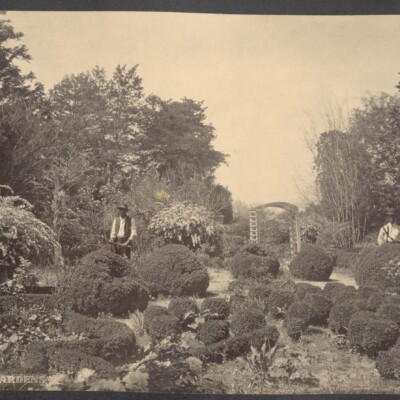Grapes
History
This area is currently closed to visitors due to boxwood blight. For more information on boxwood blight, please see our Portico articles, “Threatening Clouds on the Horizon” and “The Storm is Here.”
A passage from the book of Numbers in the Bible inspired Sarah Ferrell to plant boxwood in the shape of a cluster of Grapes. In the scripture, Moses sent spies into Canaan—the “promised land”—to survey it, and they returned with a bunch of grapes so large it required two men and a pole to transport it. Sarah called this design “The Grapes of Eschol”. The boxwood grape design shows the outline of the leaves with the stem in the middle and the small round boxwood shrubs that comprise the “cluster” of grapes.
There is also a family story that says Sarah sculpted the Grapes in boxwood because she had been promised a gift of land from her parents when she married. Alice Callaway said that Sarah was such a favored child that she was allowed to choose any parcel of land from her father’s holdings that she wanted; she then picked this hill, which had already been terraced for agricultural purposes. The home that she and Blount lived in sat in the location that the Callaway home does now—at the crest of that hill overlooking the garden on its south side. Near the grapes is a large ginkgo tree that Mrs. Ferrell planted in the mid-1800s. It is one of the largest ginkgoes in the southeast and would have been a rare plant during the time that it was planted here. Even now, it is one of the most treasured trees in the garden. In the video below, you can hear Alice talk about the ginkgo and Grapes during her 1994 recorded interview.
Horticultural Specimens
- Camellia (Camellia japonica ‘Pink Perfection’) on top of back [south] wall of garden. Blooms winter to early spring. Planted by Alice.
- Fragrant snowbell (Styrax obassia) on wall under ginkgo. Blooms white in spring. Planted by Alice, 1981.
- Ginkgo (Ginkgo biloba) tree in large bed just west of Grapes. Brilliant yellow foliage in November. Planted mid-1800s by Sarah Ferrell. A Portico article regarding the Ginkgo is “Ginkgo: A Living Fossil.”
- Variegated holly tea olive (Osmanthus heterophyllus ‘Variegatus’) on back [south] wall under gingko. Planted by Alice.










